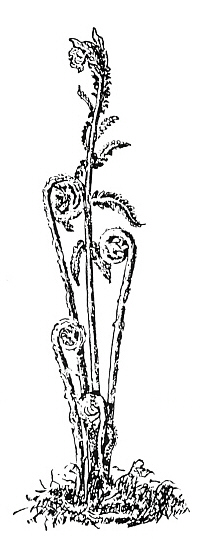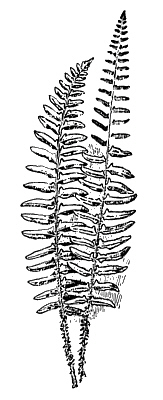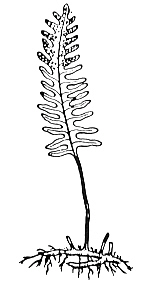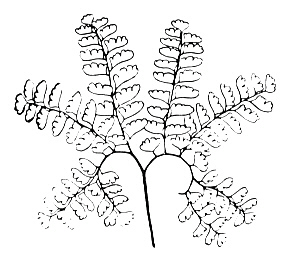QBARS - v31n1 Ferns for your Rhododendron Garden
Ferns For Your Rhododendron Garden
Joann Knapp, Locust Valley, New York
Reprinted from the New York Chapter Newsletter
Until a couple of years ago, when someone mentioned ferns to me, I vaguely pictured in my mind's eye cool, filmy green plants of intermediate size, and determined to learn more about them "later". When we moved about three years ago, and shifted from a sunny garden to a shady woods, my dormant love of wild flowers awoke and I sought to learn as much about them as I could in as short a time as possible. List after list of desirable wild flowers ended "and, of course, violets and ferns". Naturally, I had to add ferns to my list of plants to "learn about" immediately. Carol Johnston, a fellow employee at Planting Fields, felt the urge at about the same time that I did, so we have spent many happy hours identifying, collecting, photographing, planting and propagating ferns. This resulted in our teaching a course on hardy ferns at Planting Fields during the following May and June and hope that we can share our enthusiasm for growing ferns with others.
To locate fern growth chronologically for rhododendron buffs, let's start with R. dauricum and the earliest spring bulbs about the first week of April. The young coiled leaves of a number of ferns are called croziers and now is the time to lift leaves and debris away from the crowns of the ferns and look for these tightly curled croziers. They will frequently be covered with tightly overlapping scales or with a dense wooly protective coating. During late summer and early fall of last year the marginal wood fern formed a crown of a dozen or more tightly closed croziers at the base of the evergreen leaves. These will be visible partially exposed above ground. Perhaps the interrupted fern, one of the earliest, may already be showing signs of growth.
By mid to late April the croziers are beginning to uncoil, stretching upward, along with many wild flowers, daffodils and R. keiskei and 'PJM'. As we pass through azalea time in mid May and into rhododendron time during late May and early June, the ferns are keeping pace, developing their own individual characteristics and lending their unique symmetry to the garden. Now the last ironclad has bloomed; rhododendrons have about had it for another year and the kids are out of school. And where are the ferns? Some have reached maturity and have already released their spores, but most are just reaching their peak of perfection. This is the most interesting time to study ferns, to learn to identify them and to appreciate what their grace and beauty can do for your now non-blooming garden.
For the rhododendron lover with a variety of micro-environments to work with, ferns will be a joy and a challenge. Almost every garden has a "low spot", a place where drainage water stands a little too long, the soil is soggy and you have incorporated sand and organic matter to lighten it all to no avail. Here, in self denfense, you've turned to R. viscosum and perhaps R. canadense , high bush blueberry, and amelanchier, but with what will you clothe their leggy stems? Ferns, of course!

|

|

|
||
| Cinnamon fern fiddleheads | Interrupted fern | Christmas fern |
Behind your shrubs plant the plumy ostrich fern, the tallest of eastern American ferns and regarded by many as its handsomest. In favorable garden conditions, especially with plenty of moisture, it can easily reach four feet in height. In front of your wet-footed friends, plant ferns that also like a very moist acid soil, cinnamon or royal or both. The cinnamon fern with its fertile "'cinnamon stick" is perhaps one of our best known native ferns on Long Island. In early spring the young croziers of "fiddleheads" may be distinguished from others by the dense coat of buff colored wool in which they are covered. By contrast, the royal fern, frequently called "flowering fern" because of its flower like fertile top, has reddish tan hairy capped croziers with lovely, wine-colored stems. These may get to be two to three feet high at maturity so give them room to spread out. You might want to add the smaller, more delicate marsh fern in the foreground but it is a spreader so plant it where it can be kept under control.
The recommended way to grow rhododendrons and azaleas is under "high shade", preferably under tap-rooted trees such as most oaks, well mulched with natural debris to keep soil moist and cool. Here again, there are a number of companion plants in ferns that delight in a moist woodland condition. The Christmas fern and the wood ferns are close to the top of my list because they are evergreen and when the "high shade" becomes bare branches, they help to keep the garden green until it is covered with snow. They also, with their fragility, break the monotony of large rhododendron leaves everywhere. The wood ferns include: Goldie's fern or giant wood fern, the largest of the wood ferns growing to four feet under favorable conditions. Goldie's is deciduous and should be planted with potato sized stones around the roots and its mulch kept moist at all times. Marginal wood fern grows to two feet with handsome leathery evergreen fronds or leaves. It will grow well on a steep hillside. Spinulose wood fern with its delicate toothed nearly evergreen fronds grows to thirty inches. Marginal and spinulose are native to Long Island and can be collected with luck and permission. Goldie's must be ordered from a fern supplier and is getting so rare that it is becoming very expensive.
Christmas fern is a must for every garden. It will tolerate a wide range of garden conditions and its dark green evergreen foliage is attractive at all seasons.
Besides the wood and Christmas ferns, there are five others that make ideal companions for rhododendrons and azaleas. The interrupted fern is one of the first to show its white cotton ball croziers in the spring. Similar to cinnamon fern, interrupted can be substituted for it if your damp shaded acid rhododendron garden is not as wet as cinnamon would like it. New York fern's slender tapering leaves rise from a creeping rhizome that in time forms a dense intertwining network. Plant it as a deciduous ground cover where it will not crowd out other species. Lady ferns add much to the woodland garden with their feathery fronds of varying shades of green and there is a red stemmed variety of special interest. The exotic fern in this list is the colorful Japanese painted fern. Although a native of Japan, this fern is perfectly winter hardy here on Long Island, and its delicate maroon and grey-green colors make it a delight in the all green months of summer. To many the maidenhair fern is the prettiest and most delicate of all our woodland ferns. It won't do as well as some of the others in an acid soil and will benefit from the addition of limestone. In her marvelous book Wild Flowers for Your Garden Helen S. Hull suggests a combination of Virginia-bluebells and maidenhair fern.
Virginia-bluebells disappear above ground after flowering and the maidenhair fern fronds unfold just as the flowers and foliage of the bluebells begin to wane. The same is true of the early flowering Dutchmans-breeches, while Christmas fern and marginal wood fern will fill the gap caused by the passing of the lovely blue phlox.

|

|
|
| Common polypody fern | Maidenhair fern |
Many ferns have an affinity for the cool damp root run afforded by rocks and the rhododendron gardener who is lucky enough to own, or wealthy enough to buy (or unscrupulous enough to steal) rocks is well on the way to a more interesting garden. Every time I drive to Westchester or New England, I want to come home with a car full of rocks to exchange for our Long Island potatoes. The common polypody or rock cap fern will eventually completely cover the tops of rocks with a creeping evergreen mat. The bulblet fern will hang gracefully down from the top of a stone wall or revel in the spray of a tiny waterfall. The spleenworts, maidenhair and ebony, with maidenhair being the smaller and more delicate of the two, provide a delightful evergreen spot of green in the rock garden with your dwarf rhododendrons. The walking fern with its very un-fernlike leaves whose tips become rooted to start new plants, should join the previous two, for by this time, you will have become not only a rhododendron collector but a fern collector as well and no fern collector should be without the unusual walking fern in his garden. All five of these ferns like limestone ledges or crevices - not an easy order for acidic Long Island - but a moist humusy soil with the addition of small pieces of limestone seems to keep them happy in a seemingly inhospitable environment.
Obviously I have omitted many ferns suitable for growing with rhododendrons and I hope I haven't missed one of your favorites. I have tried only to skim the surface and whet your appetites. I have purposely avoided mentioning the following four ferns as I feel they have more faults than virtues: bracken fern is large, coarse and is a native of poor soil and waste places; hay-scented fern spreads rapidly and gets very ratty looking by late summer; sensitive fern is another spreader and is too coarse; and finally Virginia chain fern can also be a rampant spreader. I feel these four should be shunned using more desirable varieties instead.
If you want more information on fern culture, I recommend F. Gordon Foster's "Ferns to Know and Grow". Take a book with you to the nursery when you go to buy ferns so you'll be able to look up cultural tips on the spot. Send for wild flower catalogs. Most of them also sell ferns. And finally, come to see us later this spring when hopefully many of the ferns I've mentioned here plus others will be acclimating themselves to our garden.
( Editor's note : For those outside the New York area, who may not be familiar with the common names of the ferns mentioned, the botanical names are listed.)
| interrupted fern Osmunda claytoniana |
| ostrich fern Matteuccia struthiopteris |
| cinnamon fern Osmunda cinnamomea |
| royal fern Osmunda regalis |
| Christmas fern Polystichum acrostichoides |
| Goldie's fern Dryopteris goldiana |
| marginal wood fern Dryopteris marginalis |
| spinulose wood fern Dryopteris spinulosa |
| New York Fern Thelypteris noveboracensis |
| lady fern Athyrium felix femina |
| Japanese painted fern Athyrium goeringianum pictum |
| maidenhair fern Adiantum pedatum |
| polypody or rock cap fern Polypodium virginianum |
| ebony fern Asplenium platyneuron |
| walking fern Camptosorus rhizophyllus |
| bracken Pteridium aquilinum |
| hayscented fern Dennstaedtia punctilobula |
| sensitive fern Onoclea sensibilis |
| Virginia chain fern Woodwardia virginica |
